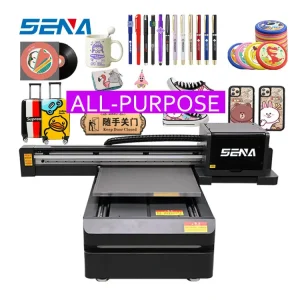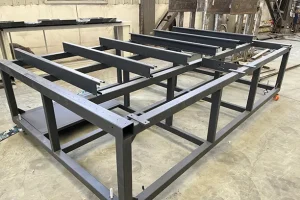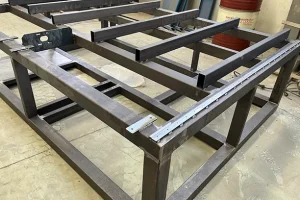Structural Support
Stability Assurance
Steel Beam Gantry Structure
Adjustable Platform
Dual – Screw Drive
Steel
Aluminum Alloy
Stainless Steel
Print Quality
Equipment Longevity

The Foundation of UV Printers
In the rapidly evolving landscape of modern printing, UV printers have emerged as a revolutionary force, transforming the way we approach various printing applications. From creating eye – catching advertising displays to adding personalized touches to consumer products, UV printers have found their niche in a wide array of industries, including signage, packaging, and custom manufacturing.
However, while much attention is often lavished on the more visible and high – tech components of UV printers, such as the advanced printheads and state – of – the – art control systems, there is one element that serves as the unsung hero of these machines: the printer frame. The frame, though not as glamorous as some of its counterparts, is the structural backbone that holds the entire UV printer together. It provides the necessary support and stability for all the other components to function optimally. Without a well – designed and robust frame, even the most advanced printhead or the most sophisticated software would be unable to deliver the high – quality, consistent results that modern printing demands.
Functions of the UV Printer Frame
Structural Support
The frame of a UV printer serves as the primary structural support for all other components of the machine. It is like the framework of a building, providing a stable and rigid foundation upon which the printer’s various parts can be mounted. For example, the printhead, which is responsible for precisely depositing ink onto the printing material, is mounted on the frame. If the frame were not there or was not strong enough, the printhead would have no proper support, and its movement during the printing process would be erratic. Similarly, components such as the ink supply system, the control panel, and the conveyor belts (in the case of roll – to – roll UV printers) are all connected to and rely on the frame for support. Without a sturdy frame, these components could shift, collide with each other, or even fall off, leading to the complete breakdown of the printer.
Stability Assurance
Stability is a crucial factor in the performance of a UV printer, and the frame plays a vital role in ensuring it. A stable frame minimizes vibrations and jolts during the printing process. When the printer is in operation, the printhead moves rapidly back and forth across the printing surface. If the frame is not stable, this movement can cause the entire printer to shake. Such vibrations can have a significant negative impact on print quality. For instance, they can lead to misalignment of the ink droplets, resulting in blurred or distorted images. In extreme cases, the printhead may even hit the printing material at an incorrect angle, causing damage to both the printhead and the material being printed.
Moreover, a stable frame also contributes to the longevity of the printer’s components. The printhead, in particular, is a delicate and expensive part. Constant vibrations can cause premature wear and tear on the printhead’s internal components, such as the nozzles and the piezoelectric actuators. By providing a stable base, the frame reduces the stress on the printhead, thereby extending its lifespan. This not only saves the user the cost of frequent printhead replacements but also ensures consistent and high – quality printing over a longer period.
Design Features of High – Quality Frames
Steel Beam Gantry Structure
A high – quality UV printer frame often features a steel beam gantry structure. This structure is typically constructed using high – strength steel materials, such as thick – walled square steel tubes. For example, an 8×10 square steel is commonly used in some industrial – grade UV printers. The use of such steel beams significantly increases the weight of the machine. This increase in weight is not a drawback but rather a key factor in enhancing the machine’s stability. According to the principle of inertia, a heavier object is more resistant to changes in its motion state. In the case of a UV printer, when the printhead moves rapidly during the printing process, the heavy gantry structure helps to keep the printer firmly in place, reducing the likelihood of unwanted vibrations or displacements.
Moreover, the surface of the steel beam gantry often undergoes a one – pass milling process, also known as “surface one – knife milling”. This precise machining operation ensures that the surface of the beam is extremely flat and smooth. The accuracy can be controlled within a very small tolerance, usually within 50 silk (0.5 mm) or even less in high – end models. This high – precision surface finish is crucial as it provides a stable and accurate mounting surface for other components of the printer, such as the linear guides and the printhead carriage. It ensures that these components can move precisely along the beam, which is essential for achieving high – quality prints with accurate positioning of the ink droplets.
Adjustable Platform
The adjustable platform is another important design feature of a UV printer frame. The printing materials used in UV printing can vary greatly in thickness, texture, and flatness. To ensure high – quality printing results on all these different materials, the printer needs to have a platform that can be adjusted to maintain a consistent distance from the printhead. A platform with multiple adjustable points is highly desirable. For instance, some advanced UV printer frames have a frame structure with nearly 30 adjustable points.
These adjustable points allow for fine – tuning of the platform’s height and levelness at different positions. By adjusting these points, the operator can ensure that the platform is perfectly flat, with a 平整度 tolerance of typically within 20 lines (a very small unit of measurement for flatness). This high – level of platform flatness is essential because even the slightest deviation can cause problems during the printing process. If the platform is not flat, the distance between the printhead and the printing material will vary across the surface. This can lead to inconsistent ink deposition, resulting in uneven colors, blurred images, or even complete print failures. Additionally, an adjustable platform can also be used to compensate for any warping or irregularities in the printing material itself, ensuring that the print quality remains high regardless of the material’s condition.
Dual – Screw Drive
In the Y – axis transmission of a UV printer, a dual – screw drive system is often employed. This system consists of two symmetrically placed screws that work together to drive the movement of the printhead carriage or the printing platform in the Y – direction. The use of a dual – screw drive offers several advantages over a single – screw drive system. Firstly, it provides better force distribution. When the printhead carriage moves, the two screws share the load, reducing the stress on each individual screw. This not only improves the mechanical efficiency of the transmission system but also increases its durability.
Secondly, the precision of the transmission is greatly enhanced. The screws used in a high – quality dual – screw drive system are usually precision – ground or “研磨螺杆” in Chinese. These screws have an extremely high precision, with an accuracy of up to 0.1 mm. This high – precision ensures that the movement of the printhead carriage in the Y – direction is smooth, consistent, and accurate. In UV printing, accurate positioning in both the X and Y directions is crucial for achieving high – resolution prints. A small deviation in the Y – axis movement can cause misalignment of the printed layers, resulting in a loss of image clarity and sharpness. With a dual – screw drive system using high – precision screws, the printer can achieve the precise positioning required for producing high – quality prints, whether it’s printing detailed graphics, fine text, or complex patterns.
Material Matters: Choosing the Right Frame Material
Steel
Steel is a popular choice for UV printer frames due to its numerous advantages. First and foremost, it offers high strength, which is crucial for supporting the heavy components of a UV printer, such as the printhead, ink tanks, and large – format printing platforms. In industrial – grade UV printers, which often handle large and heavy printing materials, the high – strength steel frame can withstand the weight and pressure without deformation. For example, a steel – framed UV printer can easily handle the printing of thick wooden boards or heavy metal sheets.
Durability is another key advantage of steel. It can resist wear and tear during the continuous operation of the printer. The all – steel welded structure further enhances the frame’s integrity and stability. Welding ensures that the different parts of the frame are firmly joined together, reducing the risk of loose connections that could lead to vibrations or misalignments during printing. Additionally, the steel frame often undergoes a tempering treatment. Tempering improves the steel’s toughness and reduces internal stress, making the frame more resistant to fatigue and extending its service life. Even after years of continuous use, a well – tempered steel – framed UV printer can still maintain its structural stability and printing accuracy.
Aluminum Alloy
Aluminum alloy frames have their own set of characteristics. One of the most notable advantages is their lightweight nature. This makes the UV printer easier to move and install, especially in situations where portability is a factor, such as in small – scale printing workshops or for on – site printing services. The cost of aluminum alloy is generally lower than that of some other high – performance materials, which can be an attractive option for manufacturers looking to keep production costs down.
However, aluminum alloy does have some limitations when it comes to UV printer frames. Its stability is not as good as that of steel. During the high – speed movement of the printhead, the relatively lower rigidity of aluminum alloy may cause the frame to vibrate more easily. These vibrations can affect the accuracy of the printhead’s movement, leading to reduced print quality. For instance, when printing high – resolution images with fine details, the vibrations from an aluminum – alloy frame could cause the ink droplets to be deposited slightly off – target, resulting in a blurry or less – sharp image. In applications that require high – precision printing, the use of an aluminum – alloy frame may not be the best choice.
Stainless Steel
Stainless steel is an excellent material for UV printer frames in terms of corrosion resistance. In environments where the printer may be exposed to moisture, chemicals (such as cleaning agents used for maintaining the printer), or high humidity, a stainless – steel frame can withstand these elements without rusting or corroding. This is particularly important in industrial settings or in areas with harsh environmental conditions. The stability of a stainless – steel frame is also very high. It offers similar or even better rigidity compared to regular steel in some cases, ensuring that the printer remains stable during operation.
Nevertheless, the main drawback of stainless steel is its relatively high cost. The production process of stainless steel, which involves the addition of elements like chromium and nickel to enhance its corrosion – resistant properties, makes it more expensive than steel or aluminum alloy. This higher cost can be a significant factor for manufacturers or buyers who are on a tight budget. However, for those who prioritize long – term durability, corrosion resistance, and high – quality printing performance, the investment in a stainless – steel – framed UV printer may be well – worth it.
The Impact of the Frame on Printing Results
Print Quality
The stability of the UV printer frame has a direct and profound impact on print quality. When the frame is unstable, it can cause a series of problems that degrade the overall visual appearance of the printed output. One of the most noticeable issues is the blurring of printed patterns. During the printing process, the printhead is designed to deposit ink droplets precisely onto the printing material. However, if the frame vibrates due to instability, the printhead’s movement will be disrupted. This disruption can cause the ink droplets to be deposited in an inconsistent manner, leading to blurred edges and a loss of sharpness in the printed image.
Printing errors can also occur due to an unstable frame. As the printhead moves across the printing surface, it needs to maintain a consistent distance from the material. If the frame is not stable, the printhead may move closer or farther away from the material at different points during the printing process. This inconsistent distance can result in uneven ink deposition. For example, in areas where the printhead is closer to the material, more ink may be deposited, leading to darker or thicker lines. In contrast, in areas where the printhead is farther away, less ink may be deposited, resulting in lighter or thinner lines. These variations in ink deposition can cause the printed image to have a patchy or inconsistent appearance.
In addition, the color transition in the printed image can be severely affected by an unstable frame. High – quality UV printing requires smooth and seamless color transitions to create natural – looking images. When the frame vibrates, the precise control of the ink droplets’ deposition, which is crucial for achieving smooth color transitions, is compromised. This can lead to visible banding or streaking in the color – gradient areas of the printed image. For instance, in a photograph printed with a UV printer, smooth skin tones or gradual color changes in the sky may appear as distinct bands of color instead of a seamless transition, making the image look unprofessional and of low quality.
Equipment Longevity
The stability of the UV printer frame is also closely related to the longevity of the printer’s other components. A stable frame plays a vital role in reducing physical wear and tear on the printer’s moving parts. For example, the printhead carriage, which moves back and forth along the frame during the printing process, is directly affected by the frame’s stability. If the frame is unstable, the printhead carriage will experience excessive vibrations and shocks. These vibrations can cause the bearings and guide rails that support the printhead carriage to wear out prematurely.
The printhead itself is also at risk of damage due to an unstable frame. As mentioned earlier, the printhead is a delicate and expensive component. Constant vibrations from an unstable frame can cause the nozzles in the printhead to become misaligned or even damaged. Misaligned nozzles can lead to inconsistent ink flow, resulting in poor print quality. In severe cases, damaged nozzles may need to be replaced, which is a costly and time – consuming process.
Furthermore, an unstable frame can also affect the lifespan of other components such as the ink supply system. The ink tubes and pumps in the ink supply system are designed to operate smoothly under normal conditions. However, vibrations from an unstable frame can cause the ink tubes to rub against other parts of the printer, leading to wear and tear. Over time, this can cause the ink tubes to develop leaks or blockages, which can disrupt the ink – delivery process and ultimately affect the printer’s performance.
By ensuring the stability of the frame, the physical stress on these components is significantly reduced. This not only extends the lifespan of the individual components but also reduces the overall maintenance and repair costs associated with the UV printer. A well – maintained and long – lasting printer can provide consistent and high – quality printing services over an extended period, making it a more cost – effective investment for businesses and users in the long run.
Conclusion: Don’t Overlook the Frame
In conclusion, the frame of a UV printer is far from being a negligible component. It is the cornerstone upon which the entire printer’s performance, print quality, and longevity are built. From providing essential structural support to ensuring stability during operation, the frame plays a multifaceted role in the overall functionality of the UV printer.
The design features of a high – quality frame, such as the steel beam gantry structure, adjustable platform, and dual – screw drive, all contribute to the printer’s ability to produce high – quality prints consistently. The choice of frame material, whether it’s steel, aluminum alloy, or stainless steel, also has a significant impact on the printer’s performance, with each material having its own set of advantages and limitations.
When considering the purchase of a UV printer, it is crucial for users to pay close attention to the quality of the frame. A well – constructed frame not only ensures better print quality but also reduces the risk of component failures and maintenance costs in the long run. By investing in a UV printer with a high – quality frame, users can expect a more reliable and productive printing experience, making it a wise choice for both small – scale businesses and large – scale industrial applications. So, the next time you’re in the market for a UV printer, don’t let the frame be an afterthought; instead, make it a key factor in your decision – making process.


